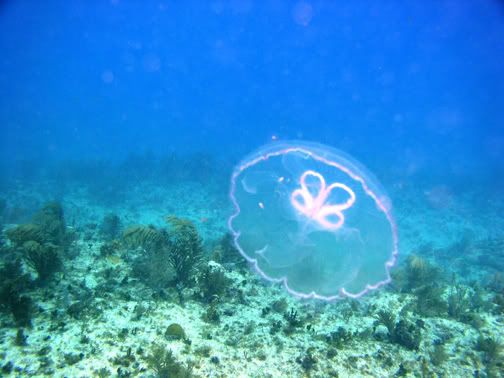"FLY" ME TO THE MOON... JELLIES
As I write this column, the moon is approaching new moon. However this past weekend, our dive trip on the warm and toasty King Neptune brought me visions of of a moon of a different sort, and it was full! Actually I was beginning to think I might be diving in the methane seas of Jupiter with its dozens of moons, because our divers were surrounded by at least a dozen of them... moon jellies or jellyfish that is! Oops, remember in this "Politically Correct" new world of biology, we are supposed to refer to them as sea jellies rather than jellyfish, but I'm sure you'll bear with me if I lapse.
I only remember filming moon jellies on one other occasion, while diving oil platform Grace off Ventura a few years back. I rarely see them here off Catalina... perhaps because I need new eyeglasses. I see the purple striped and fried egg jellies more often, but even these are fairly infrequent. At that time a biologist friend of mine with the Cousteau Society had suggested the ones from Platform Grace were the species Aurelia aurita. However in my research for this column (you think all this is stored in my feeble brain?), I discovered that this species, while found occasionally in the eastern Pacific, is not native to the West Coast. That species may be endemic (found as a native species) only in Europe, and have been introduced to Japan, the Gulf of Mexico and the East Coast (of the USA, not Catalina!).
The moon jelly I filmed may well be Aurelia labiata instead which is native to the West Coast. In fact, it is found from SE Alaska south to Newport Beach (at least for the individuals that can afford "real estate" there) or San Diego, and off Hawaii. I am told that even specialists can find it difficult to distinguish species of hydromedusae, the group to which moon jellies belong. I am certainly no specialist, and I don't carry a microscope with me when I dive to examine the diagnostic features of the critters I encounter.
Although they are often referred to as a pelagic or open water planktonic critter, moon jellies tend to float near the surface, often in warm nearshore waters such as bays and harbors. This may be one reason they aren't seen in our offshore waters as frequently as they are near the mainland.
There apparently are three separate types of this species which are segregated geographically. The southernmost population is found from San Diego to Marina del Rey; the central type is found from Santa Barbara to Newport, Oregon; and the northern population from Puget Sound to Alaska. They differ in the shape of the manubrium, the nature of the radial canals that extend from the center of the bell, the structure of the oral arms and the color of the larvae. Scientists call populations of the same species with different structural features "morphotypes."
This moon jelly reaches a diameter of about 16 inches. The margin of their bell is scalloped (not to be confused with the edible scallop or scalloped potatoes) into 8 major lobes. Their color is an opaque milky white, sometimes with splashes of pink, lavender or yellow. No "blue moons" in this species, at least not according to the field guides! The cone-shaped manubrium, or central portion that includes the mouth and arms, hangs slightly below the disc. The tentacles may be very fine and numerous, but are also short and do not trail far behind the individual which makes them much less apparent.
This species is usually seen, often in large aggregations, during late summer and fall so their appearance in winter may be somewhat unusual. The sexes are separate. Although some sources state the gonads are evident as horseshoe or round shaped structures seen under the central upper surface of the bell, those are actually the upper ends of the four stomach pouches. The gonads are located below them. Reproduction may occur during these "gatherings." for males can be seen trailing long strands of sperm. Perhaps the aggregations are like the be-ins or love-ins I experienced in the 60's (of which I will not name names since I was there... and therefore can't remember). Males and females release their sperm and eggs into the water column, but females carry the developing larvae on their manubrium.
Eventually the young larvae come loose, and settle as upright polyps attached to the substrate. These polyps reproduce asexually, by budding off new individual polyps. At some point these polyps strobilate (don't you just love the words we scientists use?). This means that they form multiple disc-shaped individuals known as strobilia that are stacked on top of one another. After about a week, these tiny medusae are released to swim free and develop into the adult medusae that we know as jellyfish... er, sea jellies. And you thought the sex lives of such simple critters was... ah, simple... didn't you!
Having covered "mating" in this species, I should give some time to "munching" as well. After all, the individual lives to eat... er, I mean eats to live... and reproduce its species. Their diet consists primarily of zooplankton, or animal plankton. Since many of these are crustaceans, relatives of the shrimp and crabs, this could be a very tasty diet! Some concern has been expressed that large concentration of these jellyfish may actually compete with plankton-eating fish of commercial value. Although many other species use long and often potent stinging tentacles, the moon jellies do not. Instead, they capture food using a mucus coating on the surface of the bell. It is then transported by cilia to tentacles on the edge of the bell and then the mouth on the manubrium.
While I'm on the topic of "munching," I should add that the moon jellies were not the only "moons" seen on this dive. There were also a number of halfmoon, sometimes called Catalina blue perch, that were as curious about the moon jellies as I was. However, they were not trying to capture them on videotape. Instead they were attacking the edges of the bell, nipping off bits of the jelly's flesh. Since the moon jellies have little defense against such attacks, I guess the halfmoon felt they were "easy pickings." Hmmm... writing on the subject of food has made me a bit hungry. Although the Chinese and Japanese are known to eat sea jellies as sushi, or dried and salted, I think I will look towards other fare on this, Stupid Bowl Sunday. Ooops, I almost forgot... I'm on a diet. It will be carrots and celery for me.
© 2008 Dr. Bill Bushing. Watch the "Dive Dry with Dr. Bill" underwater videos on Catalina Cable TV channel 49, 10:00 AM and 5:00 PM weekdays. My latest DVD on Sharks and Rays of Southern California should be available at the end of February. Yes, take Dr. Bill home with you... we'll both be glad you did! For more information see my website www.StarThrower.org/products/DVD.htm or call 310-510-8436.
Image caption: The underside of the moon jelly's bell showing central manubrium (top) and radial canals; the upper stomach and gonad rings and a halfmoon eating a moon jelly.

Edited by drbill, 11 February 2008 - 10:51 AM.


















